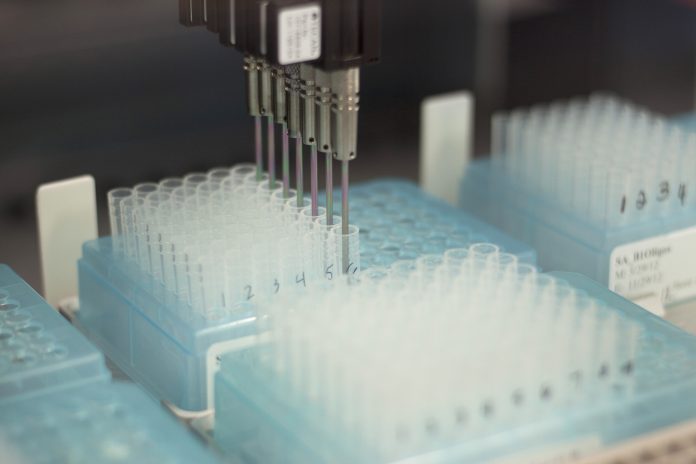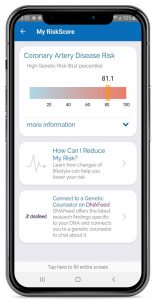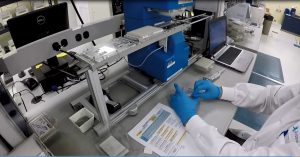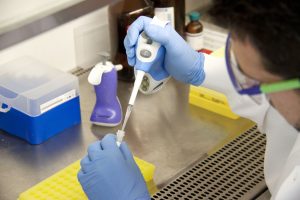
The coming decade is guaranteed to bring a panoply of emerging fields will help us better understand the intersection between genetics and health and how to incorporate them into routine medical practice. Polygenic risk scores (PRS) is, perhaps, at the top of the “must watch” list. With a firm footing in the cardiovascular space, some say PRS will become a mgajor player in how patients manage their health. Indeed, some companies have already begun providing PRS data to their customers. Given that the science behind PRS is still in its infancy, is the information ready for dispersal and quotidian discussion in doctors’ offices?
Many common diseases, including coronary artery disease (CAD), type 2 diabetes, cancer, and brain disorders are mediated by a collection of common and low-frequency genetic variants—most of which remain unknown. Each variant has a small effect, but, taken together, they could indicate a person’s overall risk of developing certain diseases (see “Polygenic Risk Score 101,” page 21). PRS offer the ability to stratify patients into risk categories based on the polymorphic variants in their genomes.
“We’ve known for decades that important diseases like heart attacks and cancers tend to run in families,” said Amit Khera, M.D., associate director, Precision Medicine Unit, Center for Genomics Medicine, Massachusetts General Hospital. “But we have not had a rigorous way to quantify this inherited risk.” PRS can directly look at a person’s DNA early in life and quantify inborn risk for these diseases by combining information from many polymorphic sites.
PRS has gained momentum for use in the clinic in recent years and is starting to cross over from academic debate into patients’ hands. But PRS are complicated and a physician’s—let alone a patient’s—understanding of genomics may not be sufficient to understand the derivation of the polygenic risk score. According to Laura Hercher, genetic counselor and director of research at the Sarah Lawrence College Graduate Program in Human Genetics, few PRS tests have clinical significance at this point, while those that do are best used to supplement and not replace existing metrics.
“People need to know the test limitations,” Hercher insisted. Knowing risk is not useful if people don’t understand the limits. For example, it is not helpful to suppose that a low score obviates the effects of obesity on diabetes and most people who have heart attacks will not have an increased PRS for CAD.
Color Genomics gets at the heart of the matter
A landmark Nature paper published by Khera, Mark Chaffin, Sekar Kathiresan and other Broad Institute colleagues in 2018 showed that PRS can be used to identify up to 8% of the population at triple the normal risk for heart attack. This implies that up to 25 million people in the U.S. are at more than triple the normal risk for CAD. These people, noted Khera, are not identified in clinical practice. If they were, individuals with a high PRS could benefit from adhering to a healthy lifestyle or taking cholesterol-lowering medicines.

Khera and Kathiresan have teamed up with Color Genomics to launch the CAD Genetic Score Report as part of a research study on how PRS scores could be applicable for population health management and to try to understand how to disclose those scores. This work makes genome-wide PRS available to Color participants for the first time.
“One of the areas right now in polygenic scores that is still being proven is the clinical utility of the score,” said Alicia Zhou, Ph.D., vice president of research and scientific affairs at Color Genomics. She told Clinical OMICs that Kathiresan and Khera have done “a huge amount of work to show that these scores have clinical validity—that they are able to accurately stratify large populations into deciles of risk of diseases.” But how will people use the information? And what is its usefulness?
Color chose to make their PRS available as a study—it is not commercially available as a product. Rather, the CAD PRS is available to individuals who have already received a test through one of Color’s existing testing panels. Launched in late 2019, the test is an optional enrollment for Color customers, with no additional cost and no direct incentive to participate.
Because some Color customers will have already received a Mendelian genetics panel regarding CAD risk, and PRS is conceptually different from more familiar monogenic diseases, the company has thought hard about how to communicate to someone that a PRS report is different than the traditional report. To help educated people on these differences, Color has developed educational content and has tele-counseling services with genetic counselors, all of whom are prepared to discuss PRS results.

In general, Zhou noted, the average person does not care whether it is monogenic or polygenic disease risk. What they ultimately want to know is whether they have increased risk and how they can mitigate that risk. “The most important things to communicate are the next steps to think about,” she said. For example, are there lifestyle changes that should be considered or should a specialist be consulted?
At Color, it uses the analogy of a marble jar. Everyone has a jar that can be filled up with marbles. When it fills to the brim, it starts overflowing, which is when a person manifests disease. So, a monogenic mutation is a big marble that cannot be changed and sets you up for a higher baseline risk than someone without that mutation. PRS may add more marbles to your jar. Lifestyle factors may also contribute marbles—or remove some of them.
One area with a significant opportunity for PRS to make an impact is in chronic disease, helping understand who will progress into acute disease versus people who will live with a chronic condition. There are many factors involved, but Zhou thinks genetics might play a role. She would love to see the work move from who does or doesn’t have disease to progression prediction.
“At the end of the day, if we believe that whole-genome sequencing is going to be a data source that will help impact people’s health management and health delivery, then PRS will be a component of that,” noted Zhou. “We talk about PRS as a bucket, but really they are different. Kathiresan and Khera’s CAD score is much more mature and ready for prime time than other scores that are under development or for phenotypes that are not well understood.”
“It’s great that Color is providing research grade polygenic risk scores,” said Ali Torkamani, Ph.D., associate professor director of genome informatics, Scripps Research Translational Institute (SRTI). He said it will be interesting to see how the company thinks about integrating with its clinical-grade monogenic risk service, as some interesting recent papers have demonstrated the significant impact that polygenic risk has on modulating monogenic risk.

Torkamani is the founder of MyGeneRank, a research study launched in 2017 by SRTI that provides PRS information on CAD to 23andMe users. The information is similar (in most cases) to the Color platform, although the specifics are different. For example, MyGeneRank combines the PRS data information with clinical risk.
An updated MyGeneRank app offers a new interface and integration with genetic counseling. It has 4,390 total users who are looking at 168 genetic risk markers—up from 57 markers when it was first launched. MyGeneRank also offers a questionnaire that combines genetic information with clinical risk. It calculates the standard score used by physicians to determine CAD clinical risk and whether a patient should be on a statin.
According to Torkamani, the genetic and clinical risk are complimentary. Think of it in two ways: 1) the genetic risk is a multiplier on your clinical risk a (high genetic risk increases the total risk by stepping up the calculated clinical risk, or clinical risk value is reduced by a low genetic risk). Alternatively: 2) if you fall into an intermediate clinical risk bucket—where there are no clear guidelines—physicians and patients should consider “other factors” and a high genetic risk might sway you towards taking a statin.
Cancer risk

Myriad Genetics
In cancer, Myriad Genetics routinely tests for eleven known genes that account for high and intermediate risk of breast cancer. But, according to Jerry Lanchbury, Ph.D., Myriad’s chief scientific officer, they account for less than 10% of the women with familial risk of breast cancer. This motivated Myriad to develop a meaningful result for the other 90% of women.
Since September 2017, Myriad has offered a physician ordered PRS test for women of European and Ashkenazi Jewish ancestry known as the “RiskScore” offering in their “MyRisk test.” MyRisk is the monogenic test and RiskScore is the polygenic test for those who are not mutation carriers. The clinical test does not combine them for carriers but the plan is to offer that in the future.
The score is delivered in two parts. One group of women received carrier status for monogenic variants and are able to have their risk managed on that basis. The other 90% of women got a PRS, combined with Tyrer-Cuzick—a breast cancer risk assessment tool used to calculate a person’s breast cancer risk based on clinical risk factors including age, BMI, obstetric history, family history, etc. Myriad said it’s the combination of PRS with Tyrer-Cuzick, that makes the results meaningful.
PRS data on top of Tyrer-Cuzick alone moves 20% of the testing population women above or below the threshold of a high-risk for developing cancer. “If you look at the academic literature, it’s the combination with risk factors that hasn’t been done,” said Lanchbury. “You see a lot of papers on PRS with no risk factors. You see PRS combined with BRCA1 and BRCA2, but you don’t see any models where it’s all properly combined and validated.”

Last December, Myriad presented a poster showing new data that combined the risk of the five most frequently mutated genes—BRCA1, BRCA2, ATM, CHEK2, and PALB2—with PRS at the San Antonio Breast Cancer Symposium (SABCS). The data showed that some of these genes have their risk modified by background genetics. For BRCA1 and BRCA2, the modification would not likely result in clinical management decision changes. But, for CHEK2, the modification from the PRS is so profound, it has as much of an effect as it does in non-carriers. So, the risk of women who are CHEK2 carriers would be moved up or down, changing clinical management decisions.
Although the tests are only available for women of European or Ashkenazi descent, Myriad is actively researching Hispanic and African American women and intend to release PRS for other ethnicities. Lanchbury told Clinical OMICs that these studies are “the biggest studies [of this kind] that have ever been done.”
Myriad relies on its network of physicians to handle patient communication, with the counseling existing within the clinical framework where they work. Their report is sent with a medical management tool attached, which explains the result and alerts the physician to key publications and supporting data. They are encouraged to think about the risk as they would manage other risks using their existing clinical management strategy. Myriad added that companies offering PRS tests direct to consumer (through Amazon, for example) is “sort of irresponsible.” The company’s stance is that this is complex information that requires a trained healthcare professional. But Myriad is not the only company offering PRS to help determine cancer risk. Ambry Genetics, founded in 1999, is a clinical genetic diagnostics company that offers PRS in their “AmbryScore” test for breast cancer. Ambry also announced, in September of 2018, the first commercially available PRS for estimating prostate cancer risk.
Risky risk

Phil Febbo, M.D., senior vice president and chief medical officer of Illumina does not see a downside to incorporating PRS into medical practice, but he does anticipate challenges. For example, because PRS combines a number of genetic variants, and the PRS can be updated and improved as more individual variants continue to be discovered, when is a PRS “ready?” Further, how can the PRS be validated and implemented into care, while allowing for continued refinement and improvement? There also exists the likelihood that there could be many PRS being used for the same condition, each with their own set of genes and mathematical algorithm. So how would a clinician choose one PRS from one source over another?
Another challenge will be incorporating PRS into the practice of healthcare professionals. And, one potential PRS downside, noted Khera, is that patients and their providers may not have the familiarity needed to understand the information provided by this new type of genetic risk factor. The Preventive Genomics Clinic at MGH has the centralized physicians, counselors, and geneticists needed for ‘genome-first’ medicine.

Another concern is the absence of a regulatory body to vet proposed PRS. Several groups or companies have started to sell scores that have not been rigorously validated or shared, or in other cases proposed to predict traits (e.g. intelligence) that may not be appropriate. Lastly, although PRS can predict risk across all racial and ethnic groups, performance is better in those of European ancestry, because the scientific community has collected the most data from these groups. Ongoing work needs to ensure analysis in more diverse populations—racially, socioeconomically, geographically, etc.
Despite the challenges ahead, Febbo asserted that “it is exciting to think of how PRS will help time-limited providers individualize their 15-minute clinic visit with patients.” Of course, Febbo added, providers are already taking into account family history, but “PRS moves away from the relatively blunt instrument of family history to a more precise estimation of individualized risk.”













